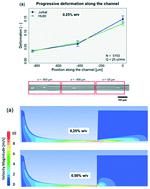Our official English website, www.x-mol.net, welcomes your
feedback! (Note: you will need to create a separate account there.)
Deformation of leukaemia cell lines in hyperbolic microchannels: investigating the role of shear and extensional components.
Lab on a Chip ( IF 6.1 ) Pub Date : 2020-06-16 , DOI: 10.1039/d0lc00166j Monica Piergiovanni 1 , Valeria Galli , Gregor Holzner , Stavros Stavrakis , Andrew DeMello , Gabriele Dubini
Lab on a Chip ( IF 6.1 ) Pub Date : 2020-06-16 , DOI: 10.1039/d0lc00166j Monica Piergiovanni 1 , Valeria Galli , Gregor Holzner , Stavros Stavrakis , Andrew DeMello , Gabriele Dubini
Affiliation

|
The mechanical properties of cells are of enormous interest in a diverse range of physio and pathological situations of clinical relevance. Unsurprisingly, a variety of microfluidic platforms have been developed in recent years to study the deformability of cells, most commonly employing pure shear or extensional flows, with and without direct contact of the cells with channel walls. Herein, we investigate the effects of shear and extensional flow components on fluid-induced cell deformation by means of three microchannel geometries. In the case of hyperbolic microchannels, cell deformation takes place in a flow with constant extensional rate, under non-zero shear conditions. A sudden expansion at the microchannel terminus allows one to evaluate shape recovery subsequent to deformation. Comparison with other microchannel shapes, that induce either pure shear (straight channel) or pure extensional (cross channel) flows, reveals different deformation modes. Such an analysis is used to confirm the softening and stiffening effects of common treatments, such as cytochalasin D and formalin on cell deformability. In addition to an experimental analysis of leukaemia cell deformability, computational fluid dynamic simulations are used to deconvolve the role of the aforementioned flow components in the cell deformation dynamics. In general terms, the current study can be used as a guide for extracting deformation/recovery dynamics of leukaemia cell lines when exposed to various fluid dynamic conditions.
中文翻译:

双曲线微通道中白血病细胞系的变形:研究剪切和延伸成分的作用。
在各种与临床相关的生理和病理情况下,细胞的机械特性引起了极大的兴趣。毫不奇怪,近年来,已经开发出各种微流体平台来研究细胞的可变形性,最常见的是采用纯剪切或拉伸流动,使细胞与通道壁不直接接触,也可以不使细胞与通道壁直接接触。本文中,我们通过三个微通道几何结构研究了剪切和扩展流动分量对流体诱导的细胞变形的影响。在双曲微通道的情况下,在非零剪切条件下,单元变形在具有恒定拉伸速率的流中发生。微通道末端的突然膨胀使人们可以评估变形后的形状恢复。与其他微通道形状的比较,引起纯剪切流(直通道)或纯拉伸流(交叉通道)的流,揭示了不同的变形模式。此类分析用于确认常见处理(如细胞松弛素D和福尔马林)对细胞变形的软化和硬化作用。除了对白血病细胞可变形性进行实验分析外,还使用计算流体动力学模拟来消除上述流动成分在细胞变形动力学中的作用。总的来说,当暴露于各种流体动力学条件下时,当前的研究可以用作提取白血病细胞系的变形/恢复动力学的指南。此类分析用于确认常见疗法(如细胞松弛素D和福尔马林)对细胞变形的软化和硬化作用。除了对白血病细胞可变形性进行实验分析外,还使用计算流体动力学模拟来消除上述流动成分在细胞变形动力学中的作用。总的来说,当暴露于各种流体动力学条件下时,当前的研究可以用作提取白血病细胞系变形/恢复动力学的指南。此类分析用于确认常见疗法(如细胞松弛素D和福尔马林)对细胞变形的软化和硬化作用。除了对白血病细胞可变形性进行实验分析外,还使用计算流体动力学模拟来消除上述流动成分在细胞变形动力学中的作用。总的来说,当暴露于各种流体动力学条件下时,当前的研究可以用作提取白血病细胞系的变形/恢复动力学的指南。
更新日期:2020-07-14
中文翻译:

双曲线微通道中白血病细胞系的变形:研究剪切和延伸成分的作用。
在各种与临床相关的生理和病理情况下,细胞的机械特性引起了极大的兴趣。毫不奇怪,近年来,已经开发出各种微流体平台来研究细胞的可变形性,最常见的是采用纯剪切或拉伸流动,使细胞与通道壁不直接接触,也可以不使细胞与通道壁直接接触。本文中,我们通过三个微通道几何结构研究了剪切和扩展流动分量对流体诱导的细胞变形的影响。在双曲微通道的情况下,在非零剪切条件下,单元变形在具有恒定拉伸速率的流中发生。微通道末端的突然膨胀使人们可以评估变形后的形状恢复。与其他微通道形状的比较,引起纯剪切流(直通道)或纯拉伸流(交叉通道)的流,揭示了不同的变形模式。此类分析用于确认常见处理(如细胞松弛素D和福尔马林)对细胞变形的软化和硬化作用。除了对白血病细胞可变形性进行实验分析外,还使用计算流体动力学模拟来消除上述流动成分在细胞变形动力学中的作用。总的来说,当暴露于各种流体动力学条件下时,当前的研究可以用作提取白血病细胞系的变形/恢复动力学的指南。此类分析用于确认常见疗法(如细胞松弛素D和福尔马林)对细胞变形的软化和硬化作用。除了对白血病细胞可变形性进行实验分析外,还使用计算流体动力学模拟来消除上述流动成分在细胞变形动力学中的作用。总的来说,当暴露于各种流体动力学条件下时,当前的研究可以用作提取白血病细胞系变形/恢复动力学的指南。此类分析用于确认常见疗法(如细胞松弛素D和福尔马林)对细胞变形的软化和硬化作用。除了对白血病细胞可变形性进行实验分析外,还使用计算流体动力学模拟来消除上述流动成分在细胞变形动力学中的作用。总的来说,当暴露于各种流体动力学条件下时,当前的研究可以用作提取白血病细胞系的变形/恢复动力学的指南。











































 京公网安备 11010802027423号
京公网安备 11010802027423号